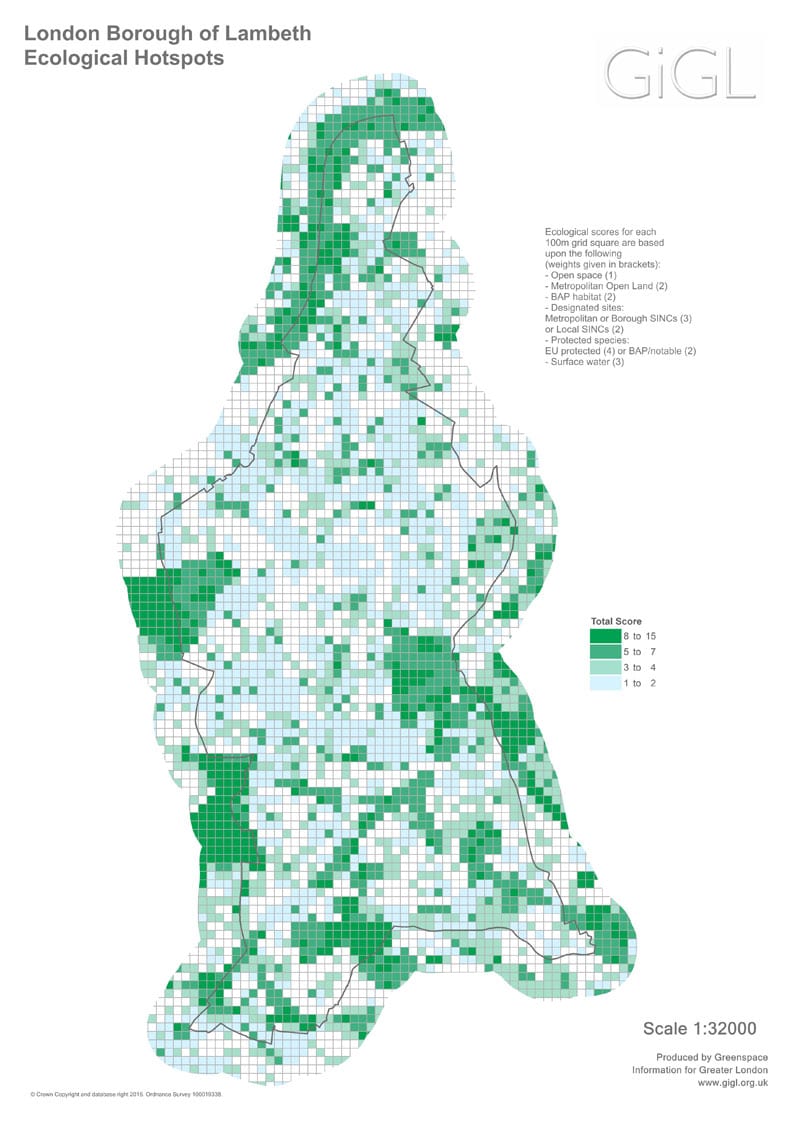To encourage idea sharing and inspire new projects, in each edition of the GiGLer, we will be highlighting a couple of examples of how GiGL partners have used their SLAs. Please get in touch if you’d like to discuss utilising any of the services mentioned, or if you have a project using GiGL data that you would like to share.
Modelling green and ecological corridors
Identifying areas of the highest environmental value is useful for many borough planning initiatives. One good way of doing this is by mapping green and ecological corridors.
The London Borough of Redbridge approached GiGL in 2014 to discuss modelling green corridors in the borough. We divided the borough into 100m grid squares and investigated the presence of a selection of green and ecological datasets within each square. Each dataset is weighted according to its importance and the totals for each 100m square are summed to produce a hotspot map showing areas of highest environmental importance. From this, green and ecological opportunity maps can be created.
While GiGL has a standard methodology in place for producing these maps, we can adjust the process to suit different requirements by altering the datasets used and weighting their scores according to local priorities and importance. Recently, the methodology has been repeated for the London Borough of Lambeth. Iain Boulton from Lambeth explains:
“In an inner London borough like Lambeth, it’s often difficult to create new wildlife sites or extensive areas of new wildlife habitat, even though that is still one of our top priorities. What we can do, however, is to work with land owners, land managers and developers to identify and secure opportunities to connect existing areas of wildlife importance with new ‘ecological corridors’ so that wild plants and animals can move between individual sites. This obviously has benefits for both migration and colonisation.
“At the same time, we can also improve the quality of any new or existing ecological corridors so that, as well as enabling species movement, we’re gradually making these corridors into important wildlife habitat in their own right; extending wildlife areas in Lambeth, and possibly even extending the boundaries of our current SINCs.
“The work we’ve been doing with GiGL on identifying our existing ecological corridors and then in creating new ones or in improving the quality and ‘reach’ of existing corridors, has been of significant benefit to us; particularly as we are now updating our Local Plan. We are now embedding the importance of green infrastructure and ecological opportunity areas into Lambeth’s development policies and into how we manage our own natural assets. GiGL’s work on this has equal benefits for neighbouring London councils and land managers, especially given how important it is to work together to secure cross-boundary and regional improvements in nature conservation, and given nature’s ability to move into new areas or become more resilient in their existing strongholds.”
Data summary and gap analysis
Auditing data doesn’t sound hugely exciting, but the results can be very insightful.
For partners who have a borough-wide or sub-regional area of interest or who focus on a particular taxonomic group, this kind of analysis involves summarising location or taxon restricted datasets into tables and graphs. The statistics can focus on particular sites of interest, for example the Sites of Importance for Nature Conservation network or on any taxonomic group or habitat type.
Audits of data richness and gap analysis work well with wildlife records, as recording effort varies temporally and spatially and can be biased by recording preference. Habitat survey data is likely to be more consistently commissioned and collected, but similar interrogation can help to summarise and understand what is present and when it was collected, particularly if surveys are ad hoc or if a high level comparison of different sites will be useful.
For wildlife records, GiGL can summarise the number of records, or recorded taxa within sites. This can reveal where in your area recording is richest and where there may be a case for focusing new efforts. Comparing this with the age of records might identify sites for which the only data are historic and which are therefore priorities for survey, as well as sites for which the most up to date recording and data sharing is already occurring. Lists of recorders per site can help to understand who, or which recording groups, are active in your area. This may help with understanding and engaging with the local recording community. It may help with identifying existing local skills and, potentially, skills gaps with opportunity for enhancement or support.

